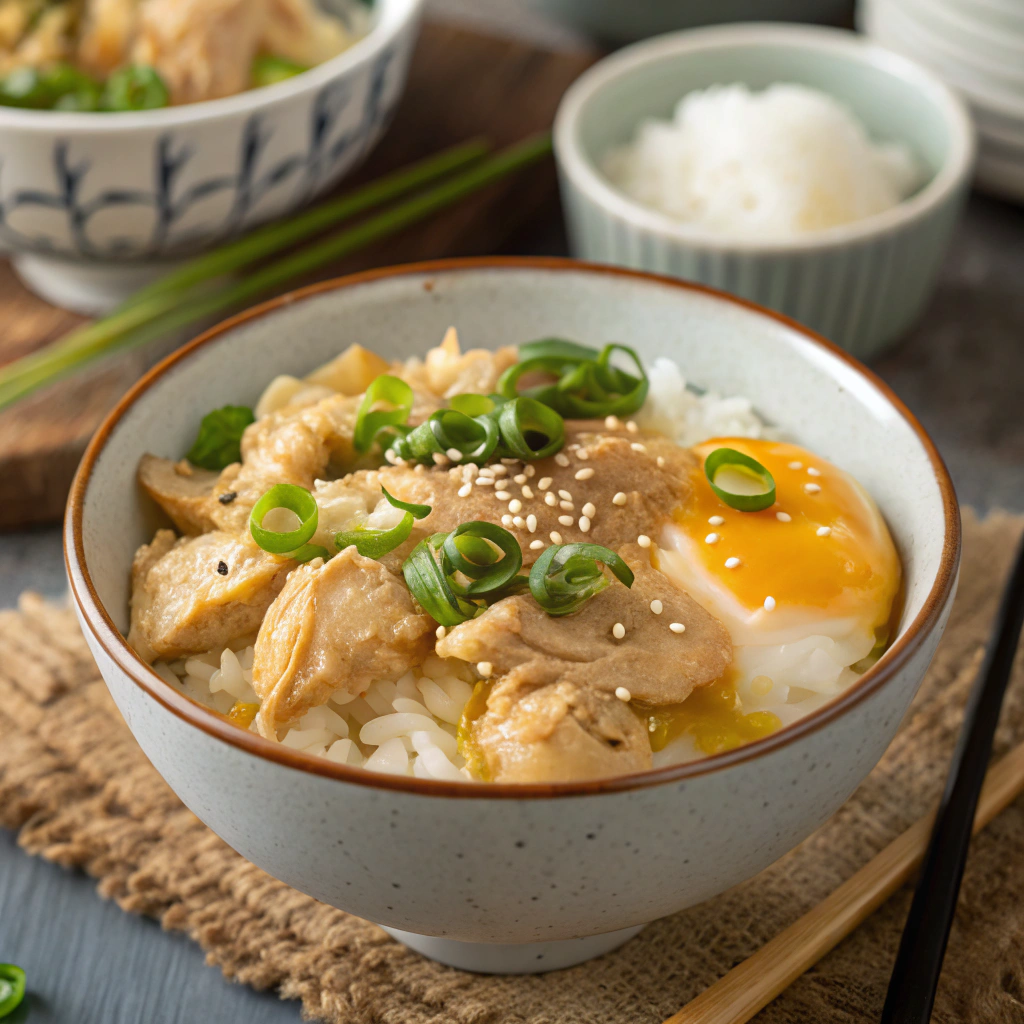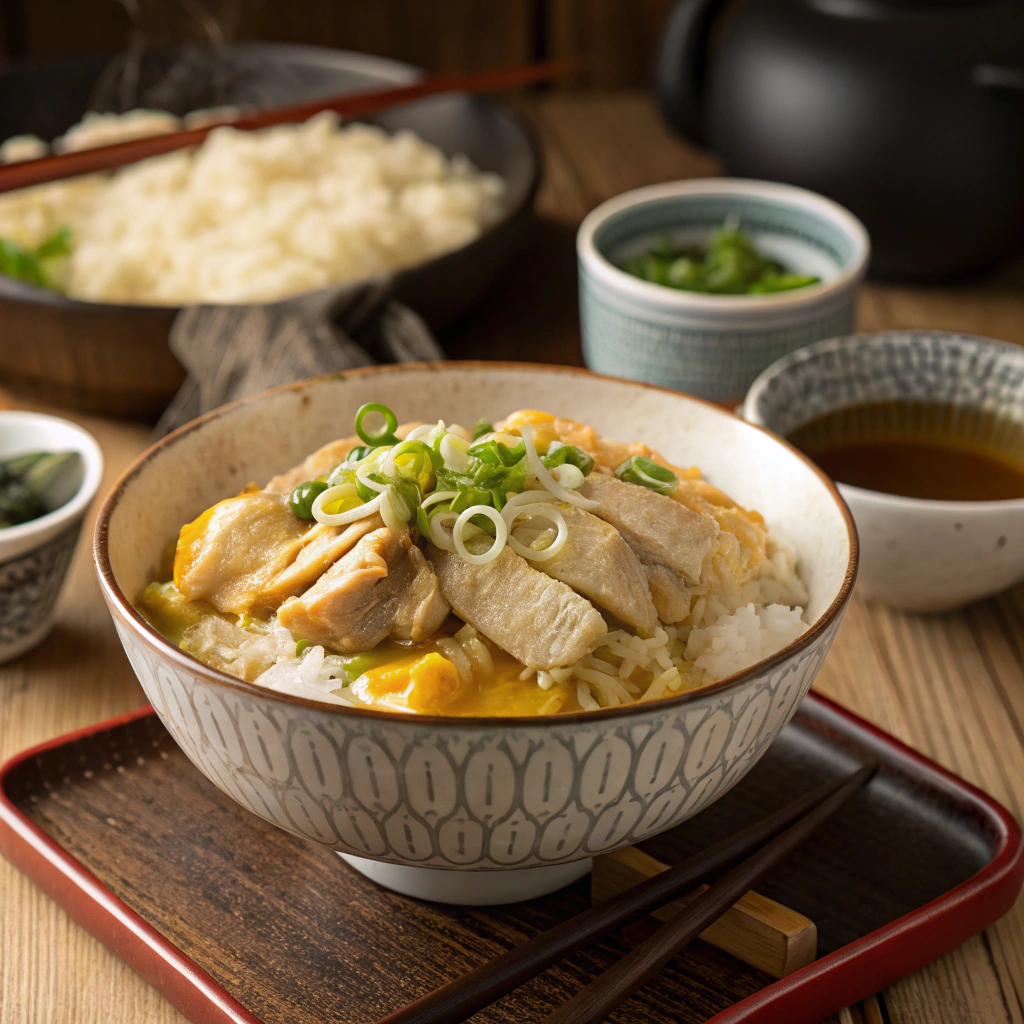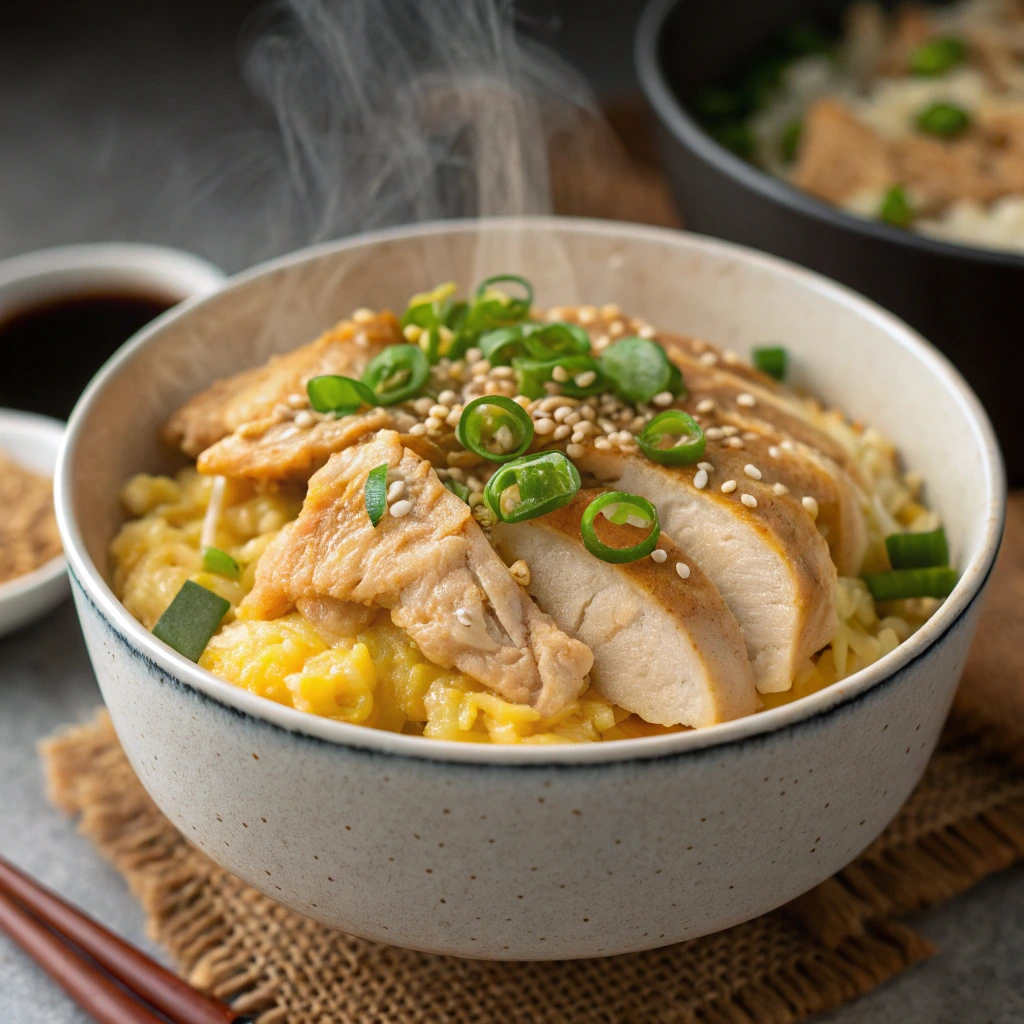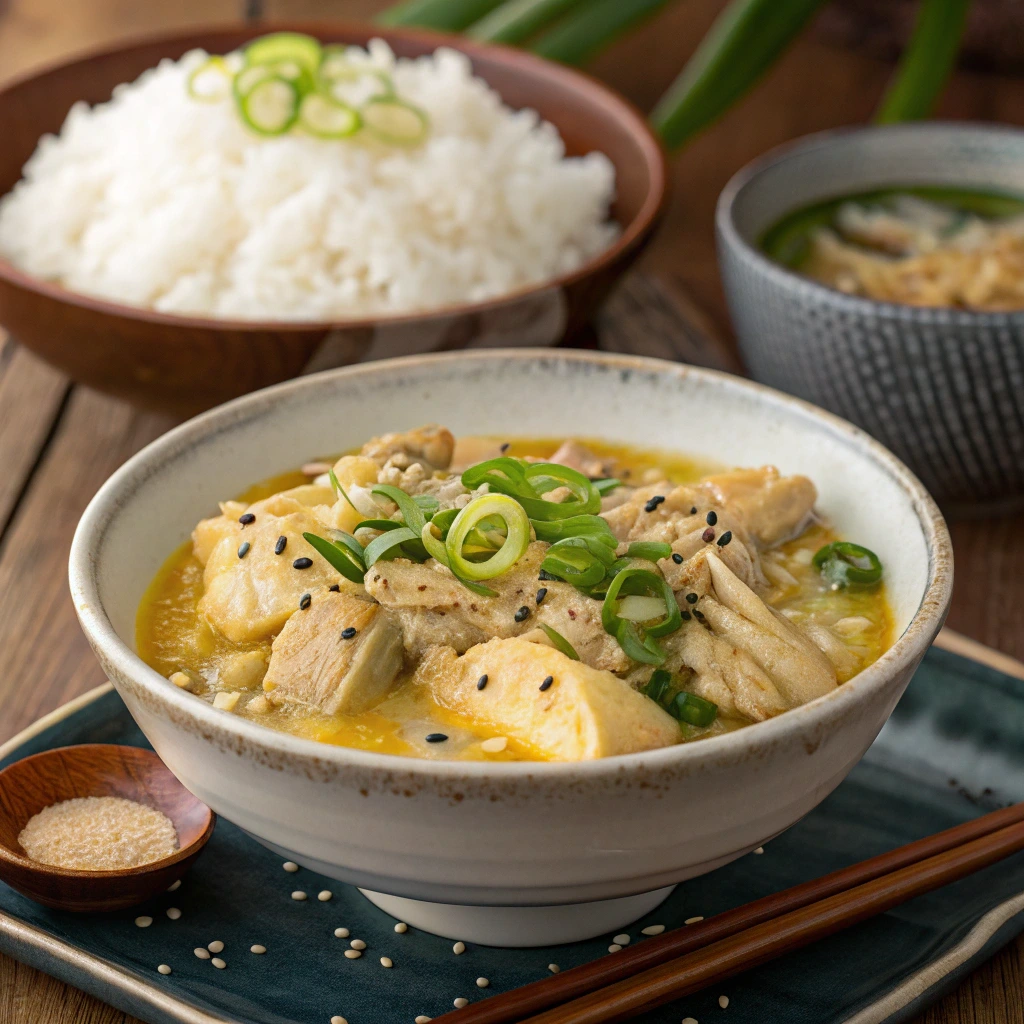
Introduction
Headline: Discover the Magic of Oyakodon: A Heartwarming Dish That Feeds Both Body and Soul
Imagine sitting down after a long day, savoring a bowl of steaming rice topped with tender chicken, creamy eggs, and aromatic seasonings. This isn’t just any meal—it’s oyakodon, Japan’s ultimate comfort food. Known for its simplicity yet rich flavors, this dish has been warming hearts and stomachs for generations. Whether you’re new to Japanese cuisine or an avid fan, learning how to make oyakodon at home is easier than you think. Let me guide you through its history, preparation, and endless possibilities.
What is Oyakodon?
Definition of Oyakodon
Oyakodon translates to “parent and child” donburi because it combines chicken (the parent) and egg (the child). It’s a classic example of donburi dishes, which are bowls of rice topped with savory ingredients. These meals are designed to be filling, quick, and deeply satisfying.
- Key Points:
- Donburi refers to rice bowl dishes in Japanese cuisine.
- Oyakodon symbolizes family unity in Japanese culture.
Key Ingredients
To create authentic oyakodon, gather these essential ingredients:
| Ingredient | Quantity |
|---|---|
| Chicken thighs (cut into bite-sized pieces) | 200g |
| Eggs | 2 large |
| Soy sauce | 2 tablespoons |
| Mirin | 1 tablespoon |
| Sake | 1 tablespoon |
| Dashi broth | 1 cup |
| Green onions (chopped) | To taste |
Optional additions include shiitake mushrooms, carrots, or ginger for extra flavor.
Why is Oyakodon Considered Comfort Food?
There’s something magical about oyakodon that makes it so comforting. Its gentle sweetness, soft textures, and warm aroma evoke feelings of home and belonging.
- Key Points:
- Simple ingredients come together to create a soul-soothing experience.
- Perfect for sharing with loved ones, making it ideal for family gatherings.
Cultural Significance
The origins of oyakodon trace back to the Meiji period when donburi dishes gained popularity as affordable and convenient meals. Over time, it became a staple in Japanese households, cherished for its ease and nourishment.
- Data/Source: According to culinary historians, donburi dishes like oyakodon were influenced by urbanization and the rise of street food culture in Japan.

Step-by-Step Guide to Making Oyakodon
Cooking oyakodon doesn’t require advanced skills—just patience and love. Follow this step-by-step guide to craft your own masterpiece.
Preparing Your Ingredients
Before you start cooking, ensure all ingredients are prepped and ready.
- Cut chicken thighs into bite-sized pieces.
- Beat the eggs lightly in a separate bowl.
- Mix soy sauce, mirin, sake, and dashi in a small container.
Cooking the Chicken
Heat oil in a skillet over medium heat and add the chicken. Cook until golden brown on all sides.
- Optional: Add minced garlic or grated ginger for enhanced aroma.
Combining Eggs and Sauce
Once the chicken is cooked, pour the sauce mixture over it and let it simmer. Then, gently stir in the beaten eggs, allowing them to cook slowly without breaking apart.
- Pro Tip: Stir minimally to maintain a creamy texture.
Serving Suggestions
Serve oyakodon hot over a bed of steamed rice. Garnish with chopped green onions or nori strips for added color and flavor.
- Presentation matters! Arrange the toppings neatly for an inviting look.
Variations of Oyakodon
While traditional oyakodon is beloved, there’s room for creativity. Here are some exciting variations to try:
Vegetarian/Vegan Oyakodon
For plant-based eaters, substitute chicken with tofu and use vegetable broth instead of dashi.
- Ingredients Needed:
- Firm tofu
- Vegetable broth
- Tofu-friendly seasoning alternatives
Spicy Oyakodon
Love heat? Add a kick to your oyakodon with red pepper flakes or chili oil.
- Balance spiciness with sweetness using additional mirin or honey.
Regional Differences
Different regions in Japan have their own take on oyakodon. For instance:
- Tokyo-style emphasizes lighter sauces.
- Osaka-style uses richer, more robust seasonings.
Modern Takes on Oyakodon
Experiment with fusion recipes, such as adding cheese or cream for a Western twist.
Health Benefits of Oyakodon
Beyond being delicious, oyakodon offers several health benefits when prepared mindfully.
Nutritional Value
Chicken and eggs provide high-quality protein, while vegetables contribute essential vitamins and minerals.
- Chicken contains lean protein, supporting muscle growth.
- Eggs offer healthy fats and nutrients like choline.
Balanced Meal Components
A typical oyakodon includes carbohydrates (rice), protein (chicken and eggs), and fiber (vegetables).
- Adjust portion sizes based on dietary needs.
Adaptability for Diets
Easily modify oyakodon to fit various diets, including gluten-free and low-carb options.
- Use cauliflower rice or quinoa as substitutes for traditional white rice.
Comfort Without Guilt
Enjoy oyakodon guilt-free by practicing moderation and mindful eating.

Fun Facts About Oyakodon
Delve deeper into the fascinating world of oyakodon with these intriguing tidbits.
Etymology of the Name
The name “oyakodon” reflects the harmonious relationship between chicken and egg, symbolizing familial bonds.
- In Japanese, “oya” means parent, and “ko” means child.
Popular Restaurants in Japan
If visiting Japan, don’t miss out on trying oyakodon at renowned establishments like Gonpachi or Sukiyabashi Jiro .
- Tourists rave about the authenticity and quality of these restaurants.
Oyakodon’s Role in Media
This iconic dish frequently appears in anime, manga, and TV shows, showcasing its cultural significance.
- Example: Characters enjoying oyakodon in popular series like My Neighbor Totoro or Food Wars!
DIY Kits and Instant Versions
Convenience seekers can opt for pre-made mixes available in grocery stores.
- While homemade versions are preferable, instant kits serve as a great alternative.
FAQ Section
Q: What is oyakodon made of?
A: Oyakodon consists of chicken, eggs, soy sauce, mirin, sake, dashi, and rice. Optional ingredients include vegetables like carrots or mushrooms.
Q: Is oyakodon healthy?
A: Yes, oyakodon provides balanced nutrition with protein from chicken and eggs, carbs from rice, and micronutrients from vegetables. Opt for whole grains and lean proteins for enhanced health benefits.
Q: Can I make vegetarian oyakodon?
A: Absolutely! Replace chicken with tofu and use vegetable broth instead of dashi for a plant-based version.
Q: Where did oyakodon originate?
A: Oyakodon traces its roots to the Meiji period in Japan, where donburi dishes gained prominence due to their convenience and affordability.
The Evolution of Oyakodon Through Time
To truly appreciate oyakodon, it’s essential to understand its evolution in Japanese culinary history.
Origins During the Meiji Period
The Meiji era (1868–1912) marked significant changes in Japanese society, including urbanization and industrialization. Street food culture flourished during this time, giving rise to quick, affordable meals like donburi dishes.
- Key Points:
- Donburi dishes became popular due to their convenience.
- Oyakodon emerged as a simple yet satisfying option for busy workers.
Adoption by Urban Populations
As cities grew, so did the demand for easy-to-prepare meals. Restaurants began offering oyakodon as a lunch special, solidifying its place in everyday life.
- Data/Source: A study published in Japanese Culinary History notes that donburi shops were among the first fast-food establishments in Japan.
Modern-Day Popularity
Today, oyakodon remains a beloved dish across generations. Its adaptability allows chefs and home cooks alike to put their unique spin on it.
- Fun Fact: In recent years, gourmet versions of oyakodon featuring premium ingredients like wagyu beef or truffle-infused sauces have gained traction.
Mastering the Art of Flavor Balance in Oyakodon
Achieving the perfect balance of flavors is key to making exceptional oyakodon. Here’s how you can elevate your dish.
Understanding Key Seasonings
Each ingredient plays a crucial role in creating the rich umami flavor profile.
- Soy Sauce: Adds saltiness and depth.
- Mirin: Provides sweetness and enhances aromatics.
- Sake: Reduces fishy odors and enriches the sauce.
- Dashi: Lends a savory base note.
Tips for Perfecting Your Sauce
Consistency is vital when preparing the sauce.
- Use equal parts soy sauce, mirin, and sake for a balanced taste.
- Adjust quantities based on personal preference but avoid overpowering the natural flavors of chicken and egg.
H3: Enhancing Aromatics
Adding fresh herbs and spices elevates the overall experience.
- Minced garlic or grated ginger infuses warmth and complexity.
- Chopped green onions not only garnish but also add freshness.

Common Mistakes to Avoid When Making Oyakodon
Even experienced cooks can fall prey to common pitfalls. Learn what to watch out for to ensure success every time.
Overcooking the Chicken
Chicken should remain tender and juicy. Cooking it too long results in dry, tough meat.
- Solution: Remove the chicken from heat once it turns opaque and let residual heat finish cooking it.
Breaking the Eggs While Stirring
Gentle stirring preserves the creamy texture of the eggs.
- Pro Tip: Use a spatula instead of a spoon for better control.
Ignoring Rice Quality
Rice forms the foundation of oyakodon. Using low-quality rice diminishes the overall dish.
- Opt for short-grain Japanese rice cooked according to package instructions.
Pairing Oyakodon with Beverages
Complement your meal with drinks that enhance its flavors.
Traditional Japanese Tea
Green tea or genmaicha pairs beautifully with oyakodon.
- Why It Works: The earthy notes of tea cut through the richness of the dish.
Sake
For a more indulgent pairing, serve oyakodon with chilled sake
- Light lagers or fruity sakes work exceptionally well.
Nutritional Breakdown of Oyakodon
Oyakodon is not only delicious but also packed with essential nutrients that contribute to a balanced diet. For those curious about its nutritional value, let’s break it down into key components. According to Healthline , eggs are one of the most nutrient-dense foods, providing high-quality protein, healthy fats, and vital vitamins like B12 and D.
Macronutrients
- Protein: Approximately 30g per serving from chicken and eggs.
- Carbohydrates: Around 50g from rice, depending on portion size.
- Fats: Healthy fats from eggs contribute roughly 10g.
Micronutrients
Eggs provide vitamin B12, iodine, and selenium, while vegetables supply fiber and antioxidants.
Customizing for Special Diets
Adjust ingredients to suit specific dietary needs:
- Low-Carb: Replace rice with cauliflower rice.
- Gluten-Free: Ensure soy sauce and other seasonings are gluten-free.
Cultural Impact of Oyakodon Beyond Food
Oyakodon transcends its status as merely a meal—it represents cultural values and traditions.
Symbolism in Family Relationships
The name “parent and child” reflects the importance of family bonds in Japanese culture.
- Reflection: Discuss how food serves as a medium for expressing love and care.
Role in Festivals and Celebrations
Oyakodon often appears at festivals and gatherings, symbolizing unity and togetherness.
- Example: At New Year celebrations, families prepare large batches of oyakodon to share.
Global Influence
As Japanese cuisine gains international recognition, oyakodon finds its way onto menus worldwide.
- Highlight global adaptations and interpretations of the dish.
Expert Insights and Interviews
Engage readers with expert perspectives on oyakodon.
Chef Recommendations
Interview renowned chefs who specialize in Japanese cuisine.
- Quote Example: “Oyakodon is all about simplicity. Let the ingredients shine without overcomplicating them.” – Chef Hiroshi Tanaka
Home Cook Tips
Feature advice from passionate home cooks who’ve mastered the art of oyakodon.
- Share personal stories and tricks they’ve learned along the way.
Conclusion
Oyakodon embodies the essence of Japanese comfort food—a harmonious blend of flavors, textures, and emotions. Whether enjoyed as a quick weeknight dinner or a special occasion treat, this dish continues to captivate hearts around the world. Armed with this guide, you’re now equipped to create authentic, delicious oyakodon that honors tradition while embracing innovation.
Final Call-to-Action: Experiment with new variations, share your creations online, and inspire others to explore the joys of Japanese cuisine. Remember, cooking is an adventure—enjoy every step of the journey!
